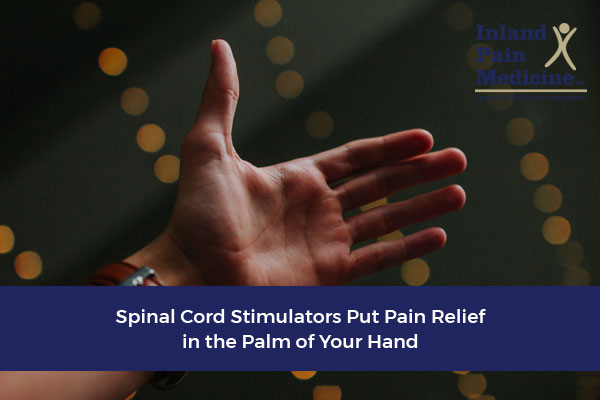
Commanding Relief: Spinal Cord Stimulators help you take control over your chronic pain without invasive surgery or opioid treatment.
Spinal Cord Stimulation, a therapy that masks pain signals before they reach the brain, is generally recommended when other pain management methods have failed. Often used in accordance with pain management treatments like exercise and relaxation methods, the Spinal Cord Stimulator (SCS) eliminates the need for invasive surgery and opioid medication, literally putting the control over your pain– and your life- in the palm of your hand.
Implanted in the epidural space around the spinal cord, the SCS stimulates the nerves of muscles by sending signals to the spine, thus blocking pain impulses, that you control with a small, hand-held device. An SCS helps to lessen chronic pain that is caused by: Complex Regional Pain Syndrome; Arachnoiditis; Sciatica; Angina; severe Diabetic Neuropathy; Peripheral Vascular Disease and Multiple Sclerosis, in addition to abdominal and perineal pain, stump pain and spinal cord injury.
Spinal Cord Stimulator vs. Spinal Cord Surgery
To reiterate, SCS procedures are most often used when other pain management options have had no positive results, yet the patient does not want to undergo Spinal Cord Surgery. That being said, SCS procedures are preferred because of the benefits that invasive surgery simply cannot offer. These advantages include:
- Reversibility. The SCS requires only a small incision and can be easily removed.
- A reduction or elimination of opioid treatments
- The ability to control or adjust the intensity and location of the stimulation
- Precise targeting of pain
- No recovery period
Is SCS Right for You?
While SCS has a high success rate, not everyone is a good candidate. Some things that you should discuss with your doctor include:
- Any history of untreated drug addiction or mental health issues.
- Any medical conditions that would contradict implementation
- If you have had previous surgery for your chronic pain
- If you have had a successful SCS trial
Your trial stimulation will determine if an SCS will work for you, depending on the location, intensity and location of your pain. Generally performed as an outpatient procedure, you will be sent home with instructions on how to use the trial stimulator. It is suggested that you write down what stimulation settings and pain relief levels that you experience while you are performing different activities. After about a week, you will return to your doctor’s office to review your results and discuss whether or not an SCS is your best treatment.
Leave a reply








I was diagnosed with Rheumatoid Arthritis (RA) 20 years ago. I have experienced whatever side effects I was warned about. The only treatment that has been successful has been the taking of worldherbsclinic RA HERBAL FORMULA, maintenance dosage of 2 in the MORNING with breakfast. I normally take 2 as usual with breakfast and one at night with dinner and have been pain-free period for more than 2 months now. I have regular blood tests and do not experience any of the side effects from taking it. Thank God this works for me. I feel great! checkout www worldherbsclinic com for more details about Rheumatoid arthritis herbal formula
Replycash price for a baclofen trial shot?
ReplyI’ve been in pain throughout my Spine from head to coccyx since 1970’s but, 5 Oct 2000 was when it started severe pain due to a trip/fall when a CNA at Braswells long term care facility. Herniated a couple vertebrae with annulus tears. I d like off opioids.
ReplyI suffered from what they called peripheral artery disease (PAD). I have been suffering for years, Me and my wife searched for a medical cure, and then we came across a testimony of a man who suffered the same and was cured by Dr Chief Lucky. So my wife and I contacted Dr Chief Lucky via an email and thank God he replied. I explained what was wrong and he sent me herbal medicines that helped heal me completely. I am happy to say that herbal medicine is the ultimate and Dr Chief Lucky I am grateful. You can contact him on his email: chiefdrlucky@gmail.com or whatsapp: +2348132777335, Dr Chief Lucky said that he also specializes in the following diseases: LUPUS, ALS, CANCER, HPV, HERPES, DIABETES, COPD, HEPATITIS B, HIV AIDS, And more.
ReplyThis blog is the nice one. Spinal Cord Stimulation is well defined so it really a informative blog.
ReplyThank you
HI, THIS IS REALY A NICE BLOG.
ReplySpine Surgery India is the most trusted spine surgery hospital in India. This spine surgery hospital India known for the best spinal treatments over the world. Here our well qualified and highly experienced surgeons ensure the higher success rate to the spine surgery.
Visit at: https://www.spinesurgeryindia.com/
Email: info@spinesurgeryindia.com